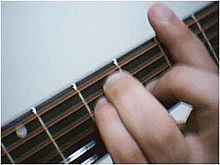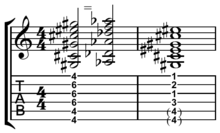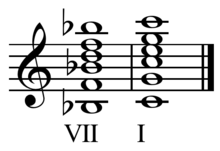- Barre chord
-
 Open E major chord, E major barre chord, then open E major chord.
Open E major chord, E major barre chord, then open E major chord.
 Play open E-major chord arpeggio,
Play open E-major chord arpeggio,
then barre, then open (help·info)In music, a barre chord (also known as bar chord or rarely barr chord) is a type of guitar chord, where one or more fingers are used to press down multiple strings across the guitar fingerboard (like a bar pressing down the strings), enabling the guitarist to play a chord not restricted by the tones of the guitar's open strings. Barre chords are often referred to as "moveable" chords[1], as the whole hand may easily be moved up and down the neck, "in one movement"[2]. Commonly used in most popular and classical music, they are frequently used in combination with "open" or standard guitar chords.
Though slightly affecting tone quality, fretting a chord transposes, or raises, the chord a number of half-steps higher, similar to the use of a capo.
Contents
Technique and application
- Note: notes of each chord are listed in order from the bottom string to the top (EADGBe).
Barre chords are typically used for more complex chord voicings and playing in keys not suitable for the more basic open chords of the first position of a standard-tuned guitar.
When fretting a barre chord, because the strings are no longer open, they do not resonate as brightly or long as an open chord. The sound is muted by the pressure placed on the bar; heavy pressure in the center of the frets produces less muting. Therefore, when playing barre chords, it is important to practice maintaining adequate pressure, as the technique is tiring for beginners and the strings dig into the flesh of the uncalloused finger.
The two most commonly barred notes are variations of A and E. These barre chords are most common in rock, blues and country music. The E barre chord is made of an E chord shape (022100) moved up and down the frets and being barred, changing the note. For example, the E chord barred one fret up becomes an F chord (133211). The next fret up is F♯, followed by G, A♭, A, B♭, B, C, C♯, D, E♭, and then back to E (1 octave up) at fret twelve.
E A E-------------0---------------5--- B-------------0---------------5--- G-------------1---------------6--- D-------------2---------------7--- A-------------2---------------7--- E-------------0---------------5--- Guitar tablature of an open E chord and an E-shape A barre chord.The A barre chord, commonly called the "double barre", is made by sliding the A chord shape (X02220) up and down the frets. When the A chord is barred, the index finger lies across the top five strings, touching the 6th string (E) to deaden it. Either the ring or little finger is then barred across the 2nd (B), 3rd (G), and 4th (D) strings two frets down, or one finger frets each string. For instance, if barred at the second fret, the A chord becomes B (X24442). From fret one to twelve, the barred A becomes B♭, B, C, C♯, D, E♭, E, F, F♯, G, A♭, and at the twelfth fret (that is, one octave up), it is A again.
A D E-------------0---------------5--- B-------------2---------------7--- G-------------2---------------7--- D-------------2---------------7--- A-------------0---------------5--- E--------------------------------- Guitar tablature of an open A chord and an A-shape D barre chord.Often the highest note in a double barre chord is left out.
All variations of these two chords can be barred: dominant 7ths, minors, minor 7ths, etc. Any major chord on the guitar can be played with A and E barre chords.
Minor barre chords are made the same as other chords, by flattening the third (in E and A shaped barre chords, this happens to be the highest 'non-barred' note). Example:
F Fm C Cm E--------1--------1--------3-------3------- B--------1--------1--------5-------4------- G--------2--------1--------5-------5------- D--------3--------3--------5-------5------- A--------3--------3--------3-------3------- E--------1--------1------------------------In addition to the two most common shapes above, barre/moveable chords can also be built around C, D and G shapes, similarly drawn from their open position equivalents. However, these shapes are not used as commonly as E and A. Example:
D A Em E--------2--------5--------3------- B--------3--------2--------5------- G--------2--------2--------4------- D--------4--------2--------2------- A--------5--------4---------------- E-----------------5----------------The above shows D major in C shape form, A major in G shape form and E minor in D shape form. The D shape, for example, can be seen as a higher voiced alternative to the standard open E minor form. Similarly, in the example above, the C shape offers an alternative voicing to an open D major or A shaped D major.
Variations of the basic major and minor triad chords can also be formed using these 5 main shapes as their foundation. For example, the open Cadd9 shape can be used in its C shape barre form up the guitar neck as desired.
The use of the plagal VII-I cadence in popular music is often attributed to the ease of sliding a barre chord up two frets[3].
In the context of classical music, "Fernando Sor recommends that one should 'be sparing of the operations called barring and shifting.' The principal reason for avoiding bars is that playing them requires more effort than not. However, there are frequent occasions when bars are the best or only solutions for playing certain passages."[4]
Small barre chords
F F E-------------1---------------1--- B-------------1---------------1--- G-------------2---------------2--- D-------------3---------------3--- A-------------3------------------- E-------------1------------------- An F-shape "great bar" chord and an F-shape "small bar" chord.Music instruction author Jerry Snyder, and others after him[1][5], distinguishes between the "great bar"/"grand bar" or full barre chord and incomplete or "small bar" chords[6][7][8]. The small bar or regular F chord is easily obtainable, but "Being able to play the Small Bar chord formations does little towards developing the technique required to play the Great Bar chord formations."[6]
Gm Gm Gm Gm7 E------3------3------3------3------ B------3------3------3------3------ G------3------3------3------3------ D------5------5-------------3------ A------5--------------------------- E------3--------------------------- E-shape Gm 'great', 'small',[8] "simplified version"[1], and Em7-shape Gm7 'small'[5] chords.The 'simplified version' on the upper three strings is described as "useful in playing solos," and may be played with any of the first three fingers[5]. The minor seventh chord whose root is located on the first may instead be considered an added sixth chord whose root is located on the third string, in which case one may consider the Gm7 a B♭add6[5].
Diagonal barre chord
 Diagonal barre chord: major seventh chord on G.[9]
Diagonal barre chord: major seventh chord on G.[9]
 Play (help·info) The first finger fingers both the second fret on the first four strings and the third fret on the sixth string.
Play (help·info) The first finger fingers both the second fret on the first four strings and the third fret on the sixth string.A diagonal barre chord is, "a very rare chord," involving, "the barring of a couple of strings with the first finger [diagonally] on different frets."[9]
Notation
The barre is often signed on tablature as "C" with the fret number as Roman numeral, such as
CVII CVIII CXII CII E--------7--------8--------13-------2------- B--------9--------8--------15-------4------- G--------9--------8--------14-------2------- D--------9--------10-------12-------4------- A--------7--------10-------12-------2------- E--------7--------8--------12-------2------- E Cm Dm B7In some notation styles (particularly classical staff notation), the "C" is usually omitted, with the number of courses to be barred (from the highest-tuned downwards) written as an index (superscript). For example: on a guitar, VII4 indicates a barre on the 7th fret over the highest four strings (D, G, B, and E). There is no rule for whether full barre chords are written with indices (e.g. "6" for a standard guitar) or without; it is a matter of personal taste for the editor.[10] It is customary to place the barre sign above the staff, with a spanning line to mark duration.[11]
See also
External links
- “Barre Chord Tips and Technique Guidelines for Improving Sound”
- “Guitar bar chord charts”
- “Comprehensive guide to guitar barre/movable chords”
References
- ^ a b c Alfred D'Auberge and Morton Manus (1968). The New Guitar Course, Book 3, p.39. ISBN 0739017799.
- ^ Moore, Allan. "The So-Called 'Flattened Seventh' in Rock", p.200n17, Popular Music, Vol. 14, No. 2. (May, 1995), pp. 185-201.
- ^ Moore (1995), p.191.
- ^ Ryan, Lee F. (1991). The Natural Classical Guitar: The Principles of Effortless Playing, p.73. ISBN 0933224508.
- ^ a b c d Ron Manus and L. C. Harnsberger (1999). From Liverpool to Abbey Road, p.111. ISBN 0739002511.
- ^ a b Jerry Snyder and Ralph Higgins (1985). Comprehensive Guitar Method: Student Book, p.9. ISBN 0898987016.
- ^ Snyder, Jerry (1987). Solo Finger Picking, p.40. Alfred Music Publishing. ISBN 0739018353.
- ^ a b Snyder, Jerry (1985). Basic Instructor Guitar, Vol 2: Student Edition, p.47. ISBN 0769209750.
- ^ a b Latarski, Don (1999). Ultimate Guitar Chords: First Chords, p.5. ISBN 9780769285221.
- ^ Del Mar, Norman (1981). Anatomy of the Orchestra. Berkley, Los Angeles: University of California Press. pp. 482–484 (1987 paperback edition). ISBN 0-520-05062-2.
- ^ Yates, Stanley (1998). "Arranging, Interpreting and Performing the Music of J. S. Bach". Six Unaccompanied Cello Suites Arranged for Guitar. Pacific, MO: Mel Bay.
Categories:- Chords
- Guitar performance techniques
Wikimedia Foundation. 2010.





